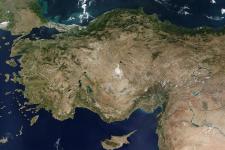
As Turkey finally makes some progress in establishing a Turkish Space Agency and the contours of a national space programme takes shape, attention is increasingly turning to Turkish ambitions to become a space launching state.
The Turkish government is intent on establishing a Turkish space launch capability in order to become as strategically autonomous as possible in its ability to project space power – the ability in peace, crisis, and war to exert influence to, in, and from space.
According to a Turkish government spokesperson quoted in Jane’s Defence Weekly:
“There are 12 countries with the capability to launch satellites and the goal is to bring Turkey into that category of nations. We will be able to increase local technological input through the Turksat 5A and 5B satellites, and hence will be able to manufacture satellite parts domestically. It will come to a point where Turkey produces the Turksat 6A communication satellite fully through local means. It is not enough to build satellites. Owning a capacity to launch satellites as well as acquiring their capabilities is also very important for self-sufficiency.”
Turkish aerospace company Rocketsan is the lead for the Turkish space launch programme and is thought to be in the process of designing a space launch vehicle (SLV) that will use liquid-fueled engines. Rocketsan is also designing all related launch infrastructure such as launch pad, launch-range equipment, and SLV telemetry systems.
While Rocketsan carries out this work, however, the Turkish government still has not decided where the Turkish launch site will be located. One area of interest is on Turkey’s southern Mediterranean coast, near Mugla. The other location is in Turkish-occupied Northern Cyprus, on the northern coast of the Mediterranean island. Both locations may work for launches into Polar orbits (from Mugla into a southern Polar orbit; Northern Cyprus into a northern Polar orbit), but both locations make any launch into an equatorial orbit challenging at best.
Both launch site locations will also draw international scrutiny, especially from Mediterranean countries, about the environmental and public safety implications of space launch over the Mediterranean Sea. Diplomatically, the choice of Northern Cyprus as a launch site would anger both Cyprus and Greece. Furthermore, the development of a Turkish SLV will stoke regional concerns that Ankara may harbour ambitions to develop a long-range ballistic missile capability.
It is unusual to start development work on an SLV and its supporting infrastructure without having first established where to actually launch satellites from, or even whether sustained satellite launch is even possible.
Despite these challenges, and the obvious geographical impediment to indigenous Turkish space launch, Ankara seems determined to pursue a measure of strategic autonomy in space launch capability. The question, however, is whether such an ambition is worth the financial and diplomatic costs and whether scarce Turkish resources might be better spent elsewhere in its nascent space programme?
Original published at: https://spacewatch.global/2017/04/turkish-space-launch-ambitions-take-shape-strategy-still-vague/
 SpaceWatch.Global An independent perspective on space
SpaceWatch.Global An independent perspective on space

